Cultural Anthropology Mini Essays: Culture, Society, and Violence
VerifiedAdded on 2022/10/11
|11
|2959
|10
Essay
AI Summary
This assignment comprises three mini-essays exploring various aspects of cultural anthropology. The first essay analyzes mixed marriages within Islamic society in Australia through the lens of cultural relativism, highlighting the clash between Islamic traditions and Western societal norms. The second essay presents an observation at a Starbucks outlet, focusing on an Indian couple's experience with a food order that violated their cultural dietary restrictions, and the outlet's response. The third essay examines the issue of domestic violence in Australia using anthropological principles, specifically the concepts of structure and agency, to understand the dynamics of power, societal influences, and individual choices within the context of domestic violence. The essays collectively showcase the application of anthropological theories to understand diverse cultural practices and social issues.
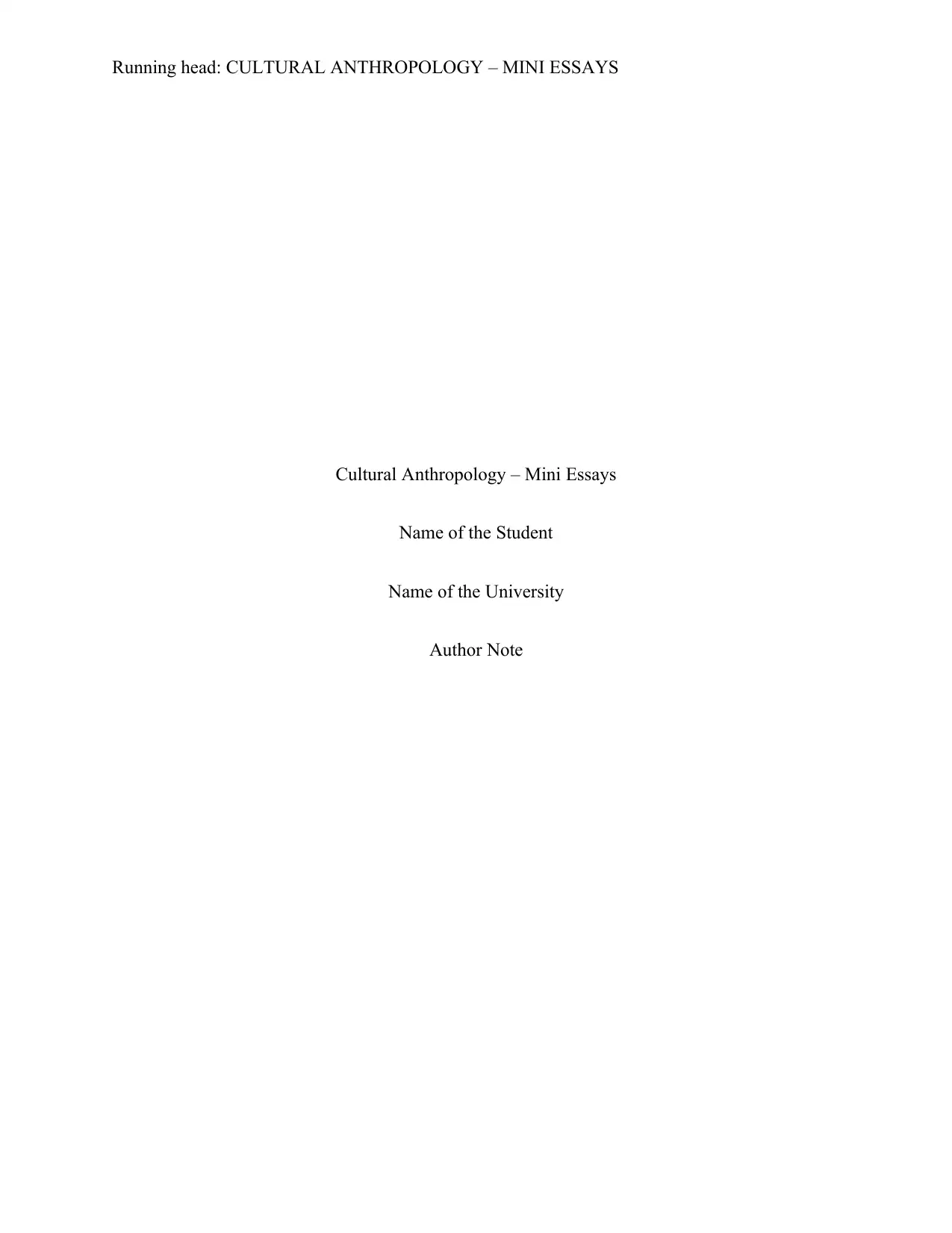
Running head: CULTURAL ANTHROPOLOGY – MINI ESSAYS
Cultural Anthropology – Mini Essays
Name of the Student
Name of the University
Author Note
Cultural Anthropology – Mini Essays
Name of the Student
Name of the University
Author Note
Paraphrase This Document
Need a fresh take? Get an instant paraphrase of this document with our AI Paraphraser
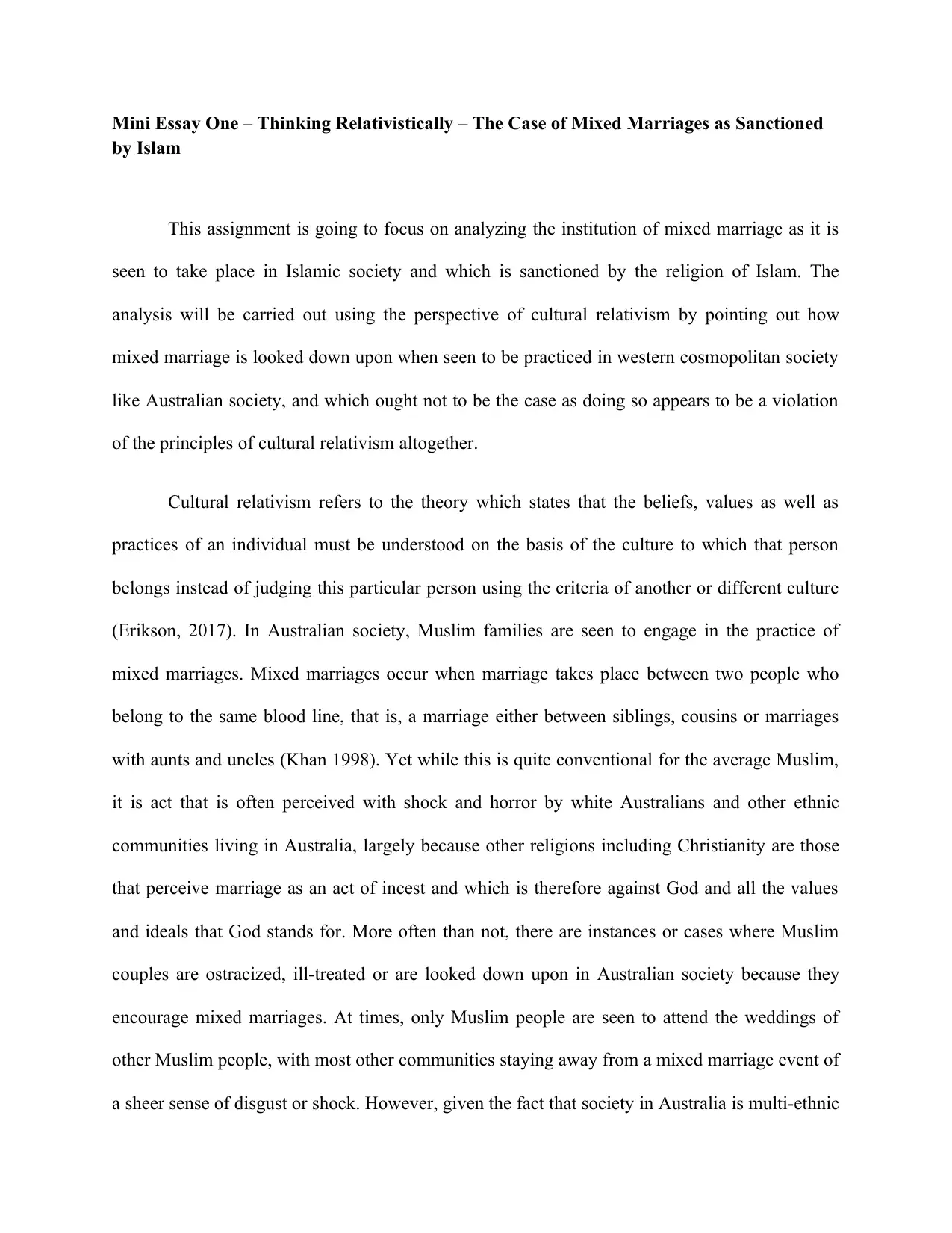
Mini Essay One – Thinking Relativistically – The Case of Mixed Marriages as Sanctioned
by Islam
This assignment is going to focus on analyzing the institution of mixed marriage as it is
seen to take place in Islamic society and which is sanctioned by the religion of Islam. The
analysis will be carried out using the perspective of cultural relativism by pointing out how
mixed marriage is looked down upon when seen to be practiced in western cosmopolitan society
like Australian society, and which ought not to be the case as doing so appears to be a violation
of the principles of cultural relativism altogether.
Cultural relativism refers to the theory which states that the beliefs, values as well as
practices of an individual must be understood on the basis of the culture to which that person
belongs instead of judging this particular person using the criteria of another or different culture
(Erikson, 2017). In Australian society, Muslim families are seen to engage in the practice of
mixed marriages. Mixed marriages occur when marriage takes place between two people who
belong to the same blood line, that is, a marriage either between siblings, cousins or marriages
with aunts and uncles (Khan 1998). Yet while this is quite conventional for the average Muslim,
it is act that is often perceived with shock and horror by white Australians and other ethnic
communities living in Australia, largely because other religions including Christianity are those
that perceive marriage as an act of incest and which is therefore against God and all the values
and ideals that God stands for. More often than not, there are instances or cases where Muslim
couples are ostracized, ill-treated or are looked down upon in Australian society because they
encourage mixed marriages. At times, only Muslim people are seen to attend the weddings of
other Muslim people, with most other communities staying away from a mixed marriage event of
a sheer sense of disgust or shock. However, given the fact that society in Australia is multi-ethnic
by Islam
This assignment is going to focus on analyzing the institution of mixed marriage as it is
seen to take place in Islamic society and which is sanctioned by the religion of Islam. The
analysis will be carried out using the perspective of cultural relativism by pointing out how
mixed marriage is looked down upon when seen to be practiced in western cosmopolitan society
like Australian society, and which ought not to be the case as doing so appears to be a violation
of the principles of cultural relativism altogether.
Cultural relativism refers to the theory which states that the beliefs, values as well as
practices of an individual must be understood on the basis of the culture to which that person
belongs instead of judging this particular person using the criteria of another or different culture
(Erikson, 2017). In Australian society, Muslim families are seen to engage in the practice of
mixed marriages. Mixed marriages occur when marriage takes place between two people who
belong to the same blood line, that is, a marriage either between siblings, cousins or marriages
with aunts and uncles (Khan 1998). Yet while this is quite conventional for the average Muslim,
it is act that is often perceived with shock and horror by white Australians and other ethnic
communities living in Australia, largely because other religions including Christianity are those
that perceive marriage as an act of incest and which is therefore against God and all the values
and ideals that God stands for. More often than not, there are instances or cases where Muslim
couples are ostracized, ill-treated or are looked down upon in Australian society because they
encourage mixed marriages. At times, only Muslim people are seen to attend the weddings of
other Muslim people, with most other communities staying away from a mixed marriage event of
a sheer sense of disgust or shock. However, given the fact that society in Australia is multi-ethnic
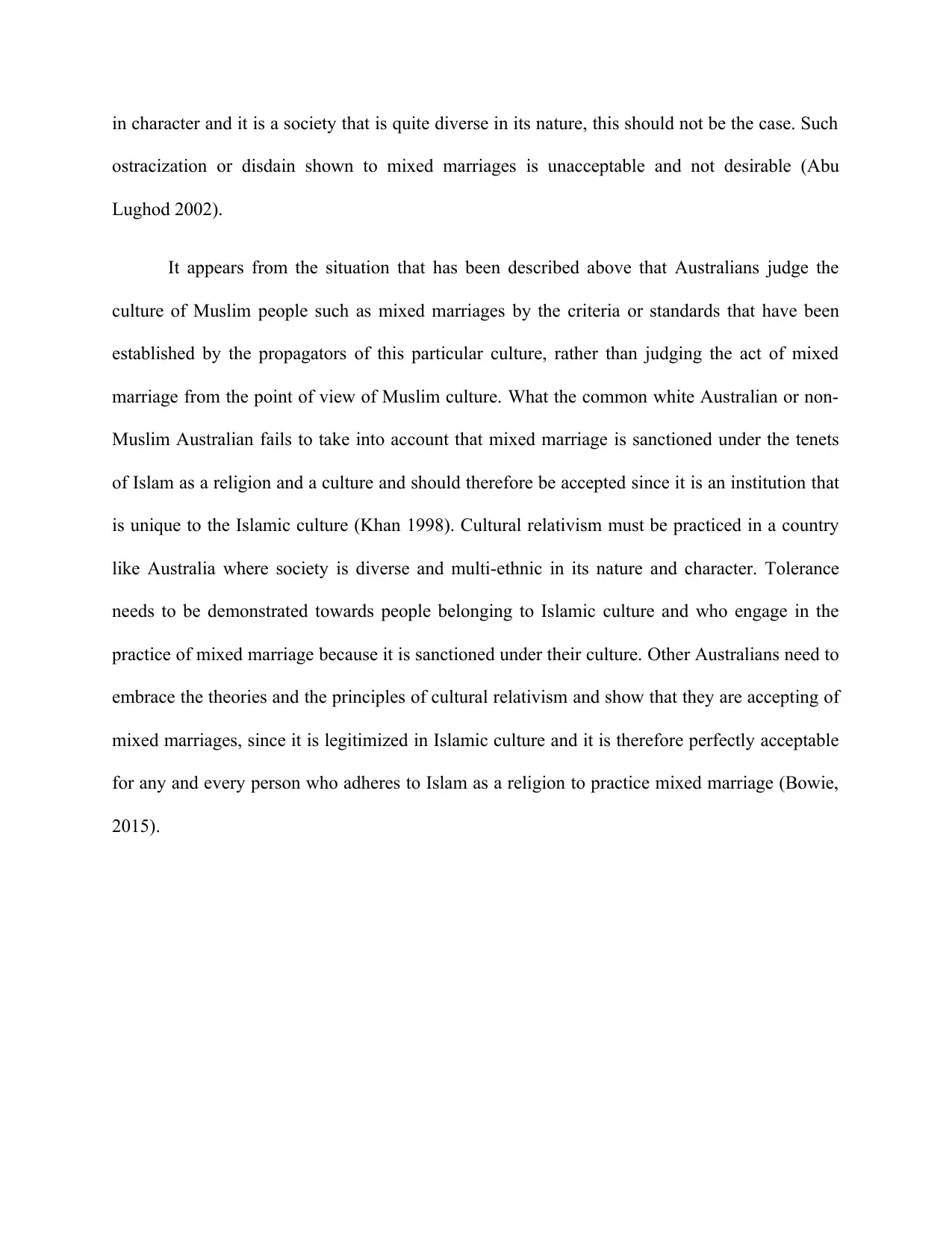
in character and it is a society that is quite diverse in its nature, this should not be the case. Such
ostracization or disdain shown to mixed marriages is unacceptable and not desirable (Abu
Lughod 2002).
It appears from the situation that has been described above that Australians judge the
culture of Muslim people such as mixed marriages by the criteria or standards that have been
established by the propagators of this particular culture, rather than judging the act of mixed
marriage from the point of view of Muslim culture. What the common white Australian or non-
Muslim Australian fails to take into account that mixed marriage is sanctioned under the tenets
of Islam as a religion and a culture and should therefore be accepted since it is an institution that
is unique to the Islamic culture (Khan 1998). Cultural relativism must be practiced in a country
like Australia where society is diverse and multi-ethnic in its nature and character. Tolerance
needs to be demonstrated towards people belonging to Islamic culture and who engage in the
practice of mixed marriage because it is sanctioned under their culture. Other Australians need to
embrace the theories and the principles of cultural relativism and show that they are accepting of
mixed marriages, since it is legitimized in Islamic culture and it is therefore perfectly acceptable
for any and every person who adheres to Islam as a religion to practice mixed marriage (Bowie,
2015).
ostracization or disdain shown to mixed marriages is unacceptable and not desirable (Abu
Lughod 2002).
It appears from the situation that has been described above that Australians judge the
culture of Muslim people such as mixed marriages by the criteria or standards that have been
established by the propagators of this particular culture, rather than judging the act of mixed
marriage from the point of view of Muslim culture. What the common white Australian or non-
Muslim Australian fails to take into account that mixed marriage is sanctioned under the tenets
of Islam as a religion and a culture and should therefore be accepted since it is an institution that
is unique to the Islamic culture (Khan 1998). Cultural relativism must be practiced in a country
like Australia where society is diverse and multi-ethnic in its nature and character. Tolerance
needs to be demonstrated towards people belonging to Islamic culture and who engage in the
practice of mixed marriage because it is sanctioned under their culture. Other Australians need to
embrace the theories and the principles of cultural relativism and show that they are accepting of
mixed marriages, since it is legitimized in Islamic culture and it is therefore perfectly acceptable
for any and every person who adheres to Islam as a religion to practice mixed marriage (Bowie,
2015).
⊘ This is a preview!⊘
Do you want full access?
Subscribe today to unlock all pages.

Trusted by 1+ million students worldwide
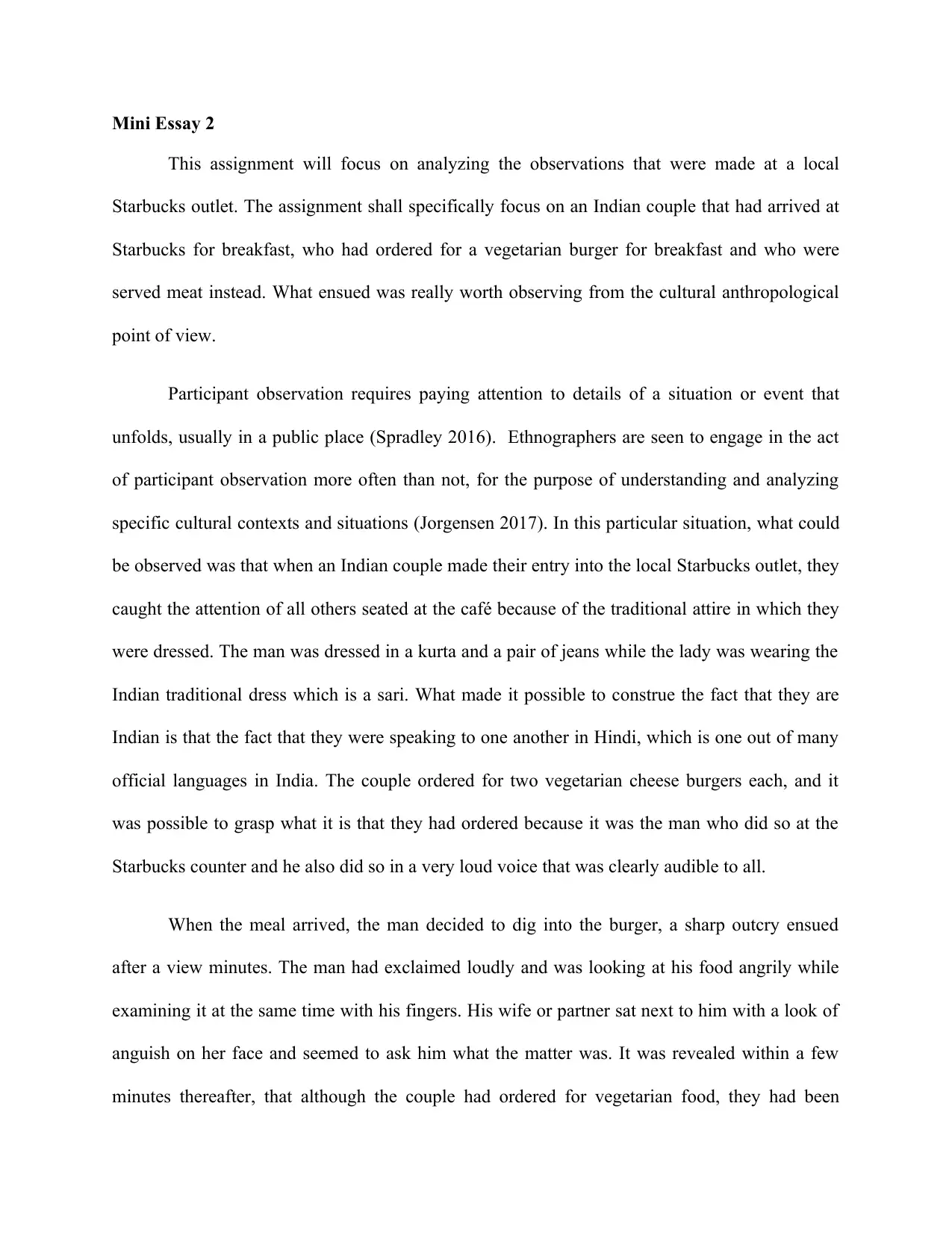
Mini Essay 2
This assignment will focus on analyzing the observations that were made at a local
Starbucks outlet. The assignment shall specifically focus on an Indian couple that had arrived at
Starbucks for breakfast, who had ordered for a vegetarian burger for breakfast and who were
served meat instead. What ensued was really worth observing from the cultural anthropological
point of view.
Participant observation requires paying attention to details of a situation or event that
unfolds, usually in a public place (Spradley 2016). Ethnographers are seen to engage in the act
of participant observation more often than not, for the purpose of understanding and analyzing
specific cultural contexts and situations (Jorgensen 2017). In this particular situation, what could
be observed was that when an Indian couple made their entry into the local Starbucks outlet, they
caught the attention of all others seated at the café because of the traditional attire in which they
were dressed. The man was dressed in a kurta and a pair of jeans while the lady was wearing the
Indian traditional dress which is a sari. What made it possible to construe the fact that they are
Indian is that the fact that they were speaking to one another in Hindi, which is one out of many
official languages in India. The couple ordered for two vegetarian cheese burgers each, and it
was possible to grasp what it is that they had ordered because it was the man who did so at the
Starbucks counter and he also did so in a very loud voice that was clearly audible to all.
When the meal arrived, the man decided to dig into the burger, a sharp outcry ensued
after a view minutes. The man had exclaimed loudly and was looking at his food angrily while
examining it at the same time with his fingers. His wife or partner sat next to him with a look of
anguish on her face and seemed to ask him what the matter was. It was revealed within a few
minutes thereafter, that although the couple had ordered for vegetarian food, they had been
This assignment will focus on analyzing the observations that were made at a local
Starbucks outlet. The assignment shall specifically focus on an Indian couple that had arrived at
Starbucks for breakfast, who had ordered for a vegetarian burger for breakfast and who were
served meat instead. What ensued was really worth observing from the cultural anthropological
point of view.
Participant observation requires paying attention to details of a situation or event that
unfolds, usually in a public place (Spradley 2016). Ethnographers are seen to engage in the act
of participant observation more often than not, for the purpose of understanding and analyzing
specific cultural contexts and situations (Jorgensen 2017). In this particular situation, what could
be observed was that when an Indian couple made their entry into the local Starbucks outlet, they
caught the attention of all others seated at the café because of the traditional attire in which they
were dressed. The man was dressed in a kurta and a pair of jeans while the lady was wearing the
Indian traditional dress which is a sari. What made it possible to construe the fact that they are
Indian is that the fact that they were speaking to one another in Hindi, which is one out of many
official languages in India. The couple ordered for two vegetarian cheese burgers each, and it
was possible to grasp what it is that they had ordered because it was the man who did so at the
Starbucks counter and he also did so in a very loud voice that was clearly audible to all.
When the meal arrived, the man decided to dig into the burger, a sharp outcry ensued
after a view minutes. The man had exclaimed loudly and was looking at his food angrily while
examining it at the same time with his fingers. His wife or partner sat next to him with a look of
anguish on her face and seemed to ask him what the matter was. It was revealed within a few
minutes thereafter, that although the couple had ordered for vegetarian food, they had been
Paraphrase This Document
Need a fresh take? Get an instant paraphrase of this document with our AI Paraphraser
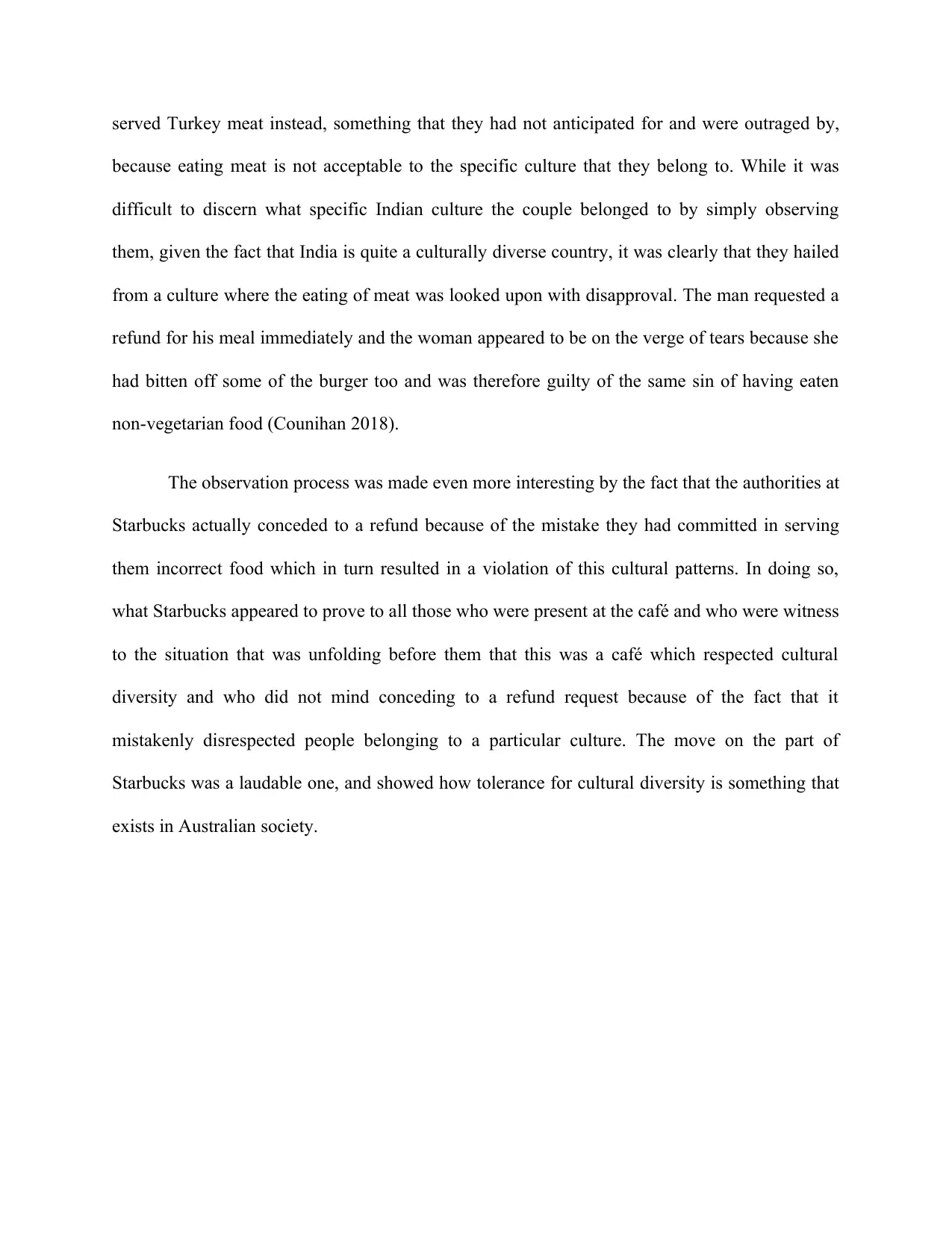
served Turkey meat instead, something that they had not anticipated for and were outraged by,
because eating meat is not acceptable to the specific culture that they belong to. While it was
difficult to discern what specific Indian culture the couple belonged to by simply observing
them, given the fact that India is quite a culturally diverse country, it was clearly that they hailed
from a culture where the eating of meat was looked upon with disapproval. The man requested a
refund for his meal immediately and the woman appeared to be on the verge of tears because she
had bitten off some of the burger too and was therefore guilty of the same sin of having eaten
non-vegetarian food (Counihan 2018).
The observation process was made even more interesting by the fact that the authorities at
Starbucks actually conceded to a refund because of the mistake they had committed in serving
them incorrect food which in turn resulted in a violation of this cultural patterns. In doing so,
what Starbucks appeared to prove to all those who were present at the café and who were witness
to the situation that was unfolding before them that this was a café which respected cultural
diversity and who did not mind conceding to a refund request because of the fact that it
mistakenly disrespected people belonging to a particular culture. The move on the part of
Starbucks was a laudable one, and showed how tolerance for cultural diversity is something that
exists in Australian society.
because eating meat is not acceptable to the specific culture that they belong to. While it was
difficult to discern what specific Indian culture the couple belonged to by simply observing
them, given the fact that India is quite a culturally diverse country, it was clearly that they hailed
from a culture where the eating of meat was looked upon with disapproval. The man requested a
refund for his meal immediately and the woman appeared to be on the verge of tears because she
had bitten off some of the burger too and was therefore guilty of the same sin of having eaten
non-vegetarian food (Counihan 2018).
The observation process was made even more interesting by the fact that the authorities at
Starbucks actually conceded to a refund because of the mistake they had committed in serving
them incorrect food which in turn resulted in a violation of this cultural patterns. In doing so,
what Starbucks appeared to prove to all those who were present at the café and who were witness
to the situation that was unfolding before them that this was a café which respected cultural
diversity and who did not mind conceding to a refund request because of the fact that it
mistakenly disrespected people belonging to a particular culture. The move on the part of
Starbucks was a laudable one, and showed how tolerance for cultural diversity is something that
exists in Australian society.
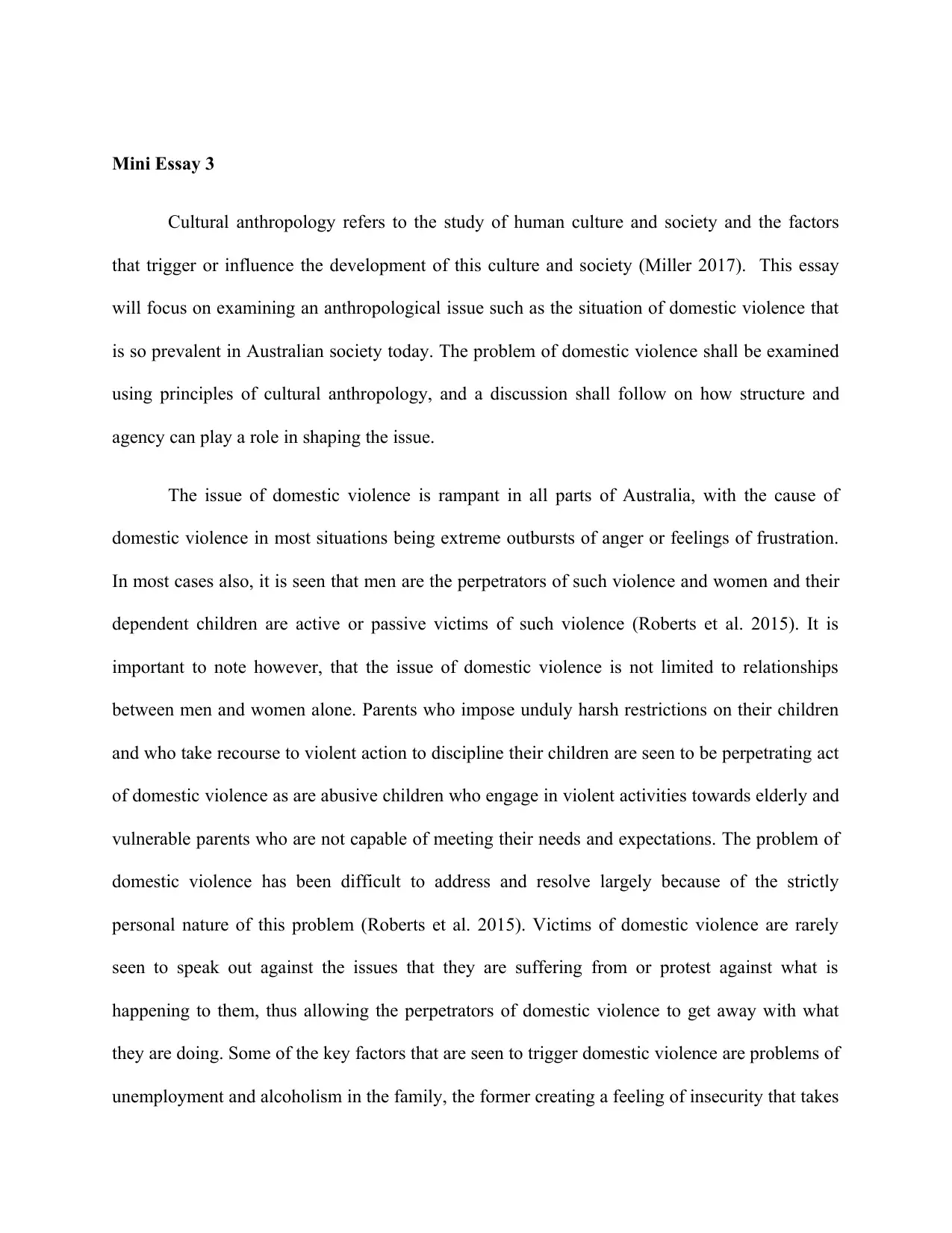
Mini Essay 3
Cultural anthropology refers to the study of human culture and society and the factors
that trigger or influence the development of this culture and society (Miller 2017). This essay
will focus on examining an anthropological issue such as the situation of domestic violence that
is so prevalent in Australian society today. The problem of domestic violence shall be examined
using principles of cultural anthropology, and a discussion shall follow on how structure and
agency can play a role in shaping the issue.
The issue of domestic violence is rampant in all parts of Australia, with the cause of
domestic violence in most situations being extreme outbursts of anger or feelings of frustration.
In most cases also, it is seen that men are the perpetrators of such violence and women and their
dependent children are active or passive victims of such violence (Roberts et al. 2015). It is
important to note however, that the issue of domestic violence is not limited to relationships
between men and women alone. Parents who impose unduly harsh restrictions on their children
and who take recourse to violent action to discipline their children are seen to be perpetrating act
of domestic violence as are abusive children who engage in violent activities towards elderly and
vulnerable parents who are not capable of meeting their needs and expectations. The problem of
domestic violence has been difficult to address and resolve largely because of the strictly
personal nature of this problem (Roberts et al. 2015). Victims of domestic violence are rarely
seen to speak out against the issues that they are suffering from or protest against what is
happening to them, thus allowing the perpetrators of domestic violence to get away with what
they are doing. Some of the key factors that are seen to trigger domestic violence are problems of
unemployment and alcoholism in the family, the former creating a feeling of insecurity that takes
Cultural anthropology refers to the study of human culture and society and the factors
that trigger or influence the development of this culture and society (Miller 2017). This essay
will focus on examining an anthropological issue such as the situation of domestic violence that
is so prevalent in Australian society today. The problem of domestic violence shall be examined
using principles of cultural anthropology, and a discussion shall follow on how structure and
agency can play a role in shaping the issue.
The issue of domestic violence is rampant in all parts of Australia, with the cause of
domestic violence in most situations being extreme outbursts of anger or feelings of frustration.
In most cases also, it is seen that men are the perpetrators of such violence and women and their
dependent children are active or passive victims of such violence (Roberts et al. 2015). It is
important to note however, that the issue of domestic violence is not limited to relationships
between men and women alone. Parents who impose unduly harsh restrictions on their children
and who take recourse to violent action to discipline their children are seen to be perpetrating act
of domestic violence as are abusive children who engage in violent activities towards elderly and
vulnerable parents who are not capable of meeting their needs and expectations. The problem of
domestic violence has been difficult to address and resolve largely because of the strictly
personal nature of this problem (Roberts et al. 2015). Victims of domestic violence are rarely
seen to speak out against the issues that they are suffering from or protest against what is
happening to them, thus allowing the perpetrators of domestic violence to get away with what
they are doing. Some of the key factors that are seen to trigger domestic violence are problems of
unemployment and alcoholism in the family, the former creating a feeling of insecurity that takes
⊘ This is a preview!⊘
Do you want full access?
Subscribe today to unlock all pages.

Trusted by 1+ million students worldwide
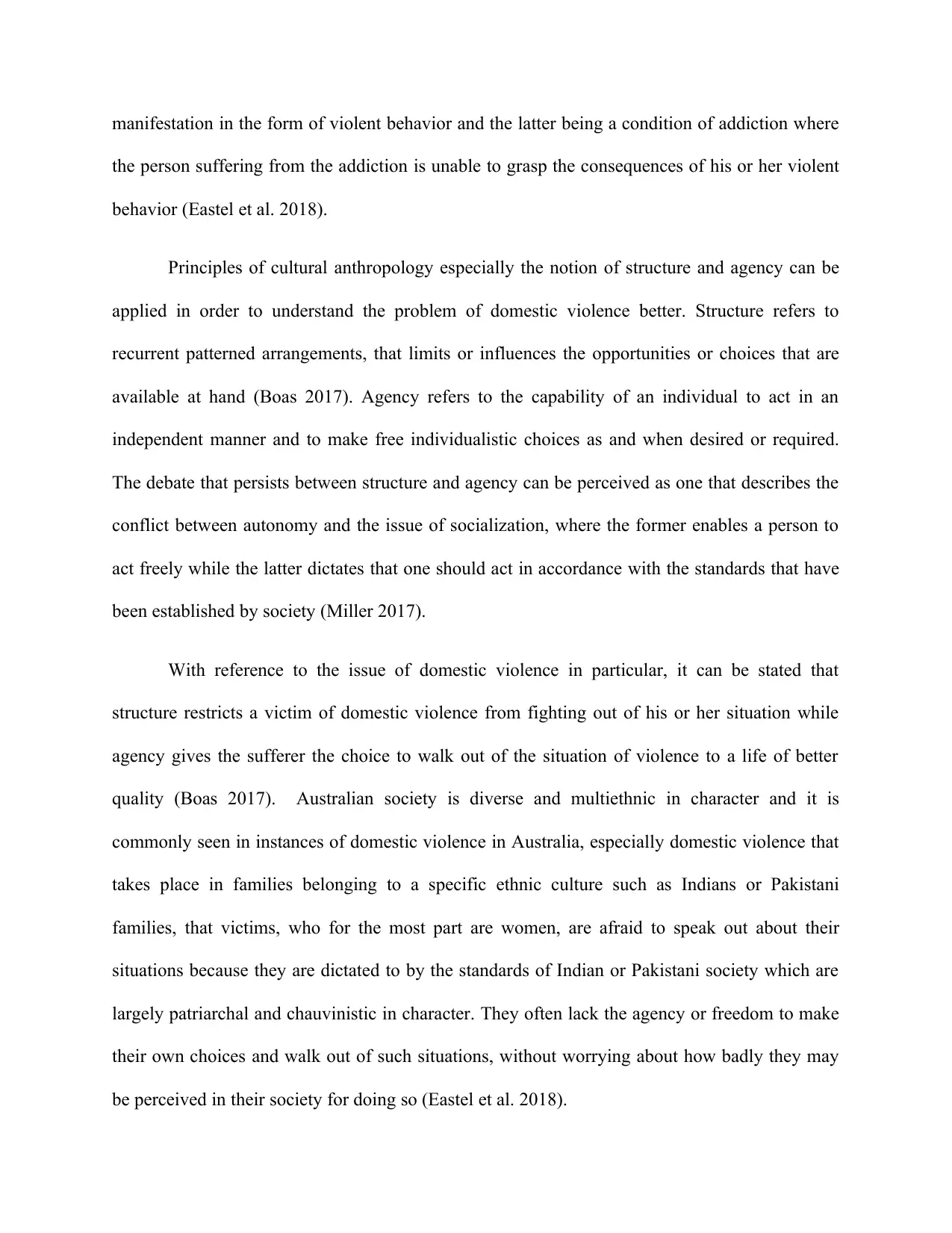
manifestation in the form of violent behavior and the latter being a condition of addiction where
the person suffering from the addiction is unable to grasp the consequences of his or her violent
behavior (Eastel et al. 2018).
Principles of cultural anthropology especially the notion of structure and agency can be
applied in order to understand the problem of domestic violence better. Structure refers to
recurrent patterned arrangements, that limits or influences the opportunities or choices that are
available at hand (Boas 2017). Agency refers to the capability of an individual to act in an
independent manner and to make free individualistic choices as and when desired or required.
The debate that persists between structure and agency can be perceived as one that describes the
conflict between autonomy and the issue of socialization, where the former enables a person to
act freely while the latter dictates that one should act in accordance with the standards that have
been established by society (Miller 2017).
With reference to the issue of domestic violence in particular, it can be stated that
structure restricts a victim of domestic violence from fighting out of his or her situation while
agency gives the sufferer the choice to walk out of the situation of violence to a life of better
quality (Boas 2017). Australian society is diverse and multiethnic in character and it is
commonly seen in instances of domestic violence in Australia, especially domestic violence that
takes place in families belonging to a specific ethnic culture such as Indians or Pakistani
families, that victims, who for the most part are women, are afraid to speak out about their
situations because they are dictated to by the standards of Indian or Pakistani society which are
largely patriarchal and chauvinistic in character. They often lack the agency or freedom to make
their own choices and walk out of such situations, without worrying about how badly they may
be perceived in their society for doing so (Eastel et al. 2018).
the person suffering from the addiction is unable to grasp the consequences of his or her violent
behavior (Eastel et al. 2018).
Principles of cultural anthropology especially the notion of structure and agency can be
applied in order to understand the problem of domestic violence better. Structure refers to
recurrent patterned arrangements, that limits or influences the opportunities or choices that are
available at hand (Boas 2017). Agency refers to the capability of an individual to act in an
independent manner and to make free individualistic choices as and when desired or required.
The debate that persists between structure and agency can be perceived as one that describes the
conflict between autonomy and the issue of socialization, where the former enables a person to
act freely while the latter dictates that one should act in accordance with the standards that have
been established by society (Miller 2017).
With reference to the issue of domestic violence in particular, it can be stated that
structure restricts a victim of domestic violence from fighting out of his or her situation while
agency gives the sufferer the choice to walk out of the situation of violence to a life of better
quality (Boas 2017). Australian society is diverse and multiethnic in character and it is
commonly seen in instances of domestic violence in Australia, especially domestic violence that
takes place in families belonging to a specific ethnic culture such as Indians or Pakistani
families, that victims, who for the most part are women, are afraid to speak out about their
situations because they are dictated to by the standards of Indian or Pakistani society which are
largely patriarchal and chauvinistic in character. They often lack the agency or freedom to make
their own choices and walk out of such situations, without worrying about how badly they may
be perceived in their society for doing so (Eastel et al. 2018).
Paraphrase This Document
Need a fresh take? Get an instant paraphrase of this document with our AI Paraphraser
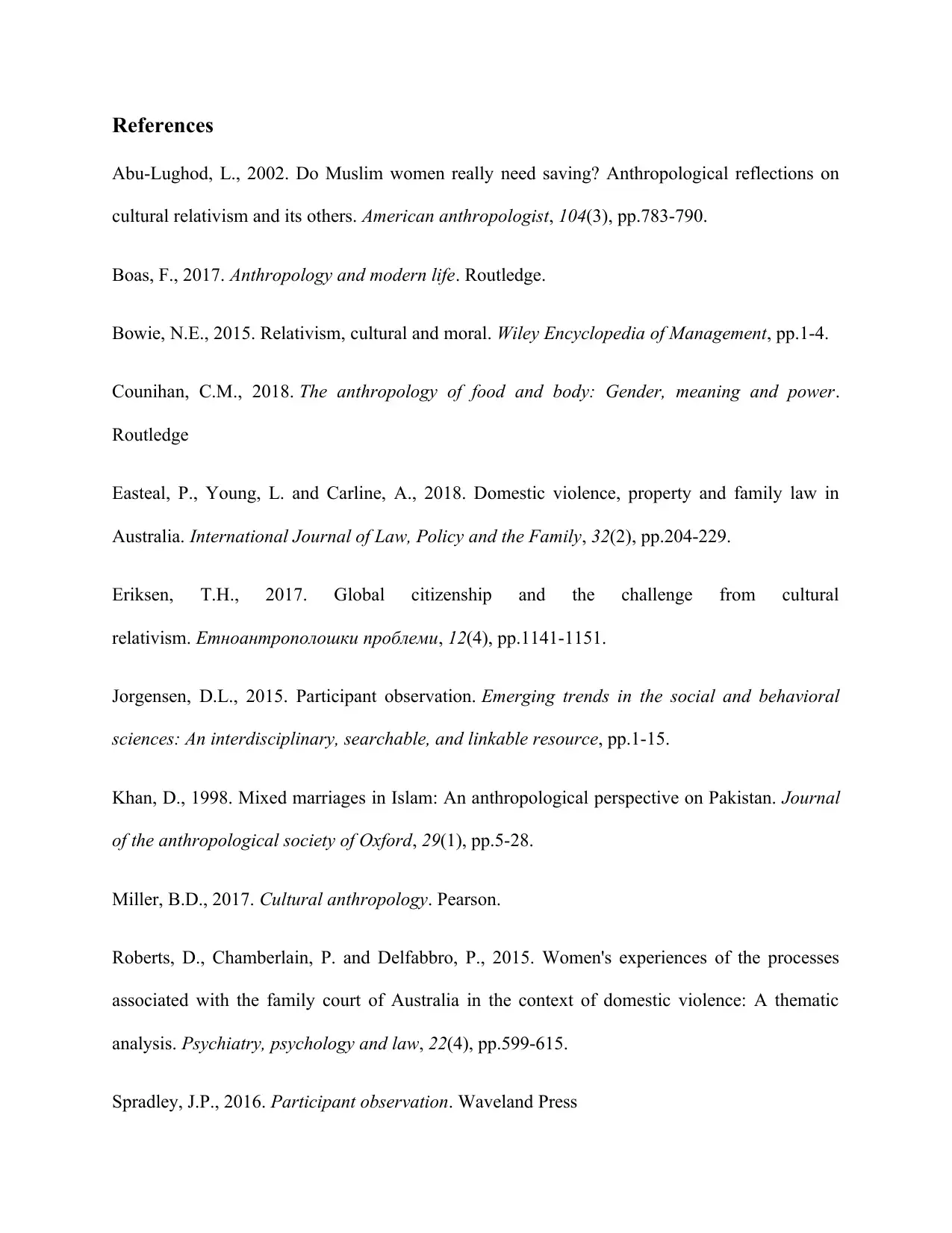
References
Abu‐Lughod, L., 2002. Do Muslim women really need saving? Anthropological reflections on
cultural relativism and its others. American anthropologist, 104(3), pp.783-790.
Boas, F., 2017. Anthropology and modern life. Routledge.
Bowie, N.E., 2015. Relativism, cultural and moral. Wiley Encyclopedia of Management, pp.1-4.
Counihan, C.M., 2018. The anthropology of food and body: Gender, meaning and power.
Routledge
Easteal, P., Young, L. and Carline, A., 2018. Domestic violence, property and family law in
Australia. International Journal of Law, Policy and the Family, 32(2), pp.204-229.
Eriksen, T.H., 2017. Global citizenship and the challenge from cultural
relativism. Етноантрополошки проблеми, 12(4), pp.1141-1151.
Jorgensen, D.L., 2015. Participant observation. Emerging trends in the social and behavioral
sciences: An interdisciplinary, searchable, and linkable resource, pp.1-15.
Khan, D., 1998. Mixed marriages in Islam: An anthropological perspective on Pakistan. Journal
of the anthropological society of Oxford, 29(1), pp.5-28.
Miller, B.D., 2017. Cultural anthropology. Pearson.
Roberts, D., Chamberlain, P. and Delfabbro, P., 2015. Women's experiences of the processes
associated with the family court of Australia in the context of domestic violence: A thematic
analysis. Psychiatry, psychology and law, 22(4), pp.599-615.
Spradley, J.P., 2016. Participant observation. Waveland Press
Abu‐Lughod, L., 2002. Do Muslim women really need saving? Anthropological reflections on
cultural relativism and its others. American anthropologist, 104(3), pp.783-790.
Boas, F., 2017. Anthropology and modern life. Routledge.
Bowie, N.E., 2015. Relativism, cultural and moral. Wiley Encyclopedia of Management, pp.1-4.
Counihan, C.M., 2018. The anthropology of food and body: Gender, meaning and power.
Routledge
Easteal, P., Young, L. and Carline, A., 2018. Domestic violence, property and family law in
Australia. International Journal of Law, Policy and the Family, 32(2), pp.204-229.
Eriksen, T.H., 2017. Global citizenship and the challenge from cultural
relativism. Етноантрополошки проблеми, 12(4), pp.1141-1151.
Jorgensen, D.L., 2015. Participant observation. Emerging trends in the social and behavioral
sciences: An interdisciplinary, searchable, and linkable resource, pp.1-15.
Khan, D., 1998. Mixed marriages in Islam: An anthropological perspective on Pakistan. Journal
of the anthropological society of Oxford, 29(1), pp.5-28.
Miller, B.D., 2017. Cultural anthropology. Pearson.
Roberts, D., Chamberlain, P. and Delfabbro, P., 2015. Women's experiences of the processes
associated with the family court of Australia in the context of domestic violence: A thematic
analysis. Psychiatry, psychology and law, 22(4), pp.599-615.
Spradley, J.P., 2016. Participant observation. Waveland Press
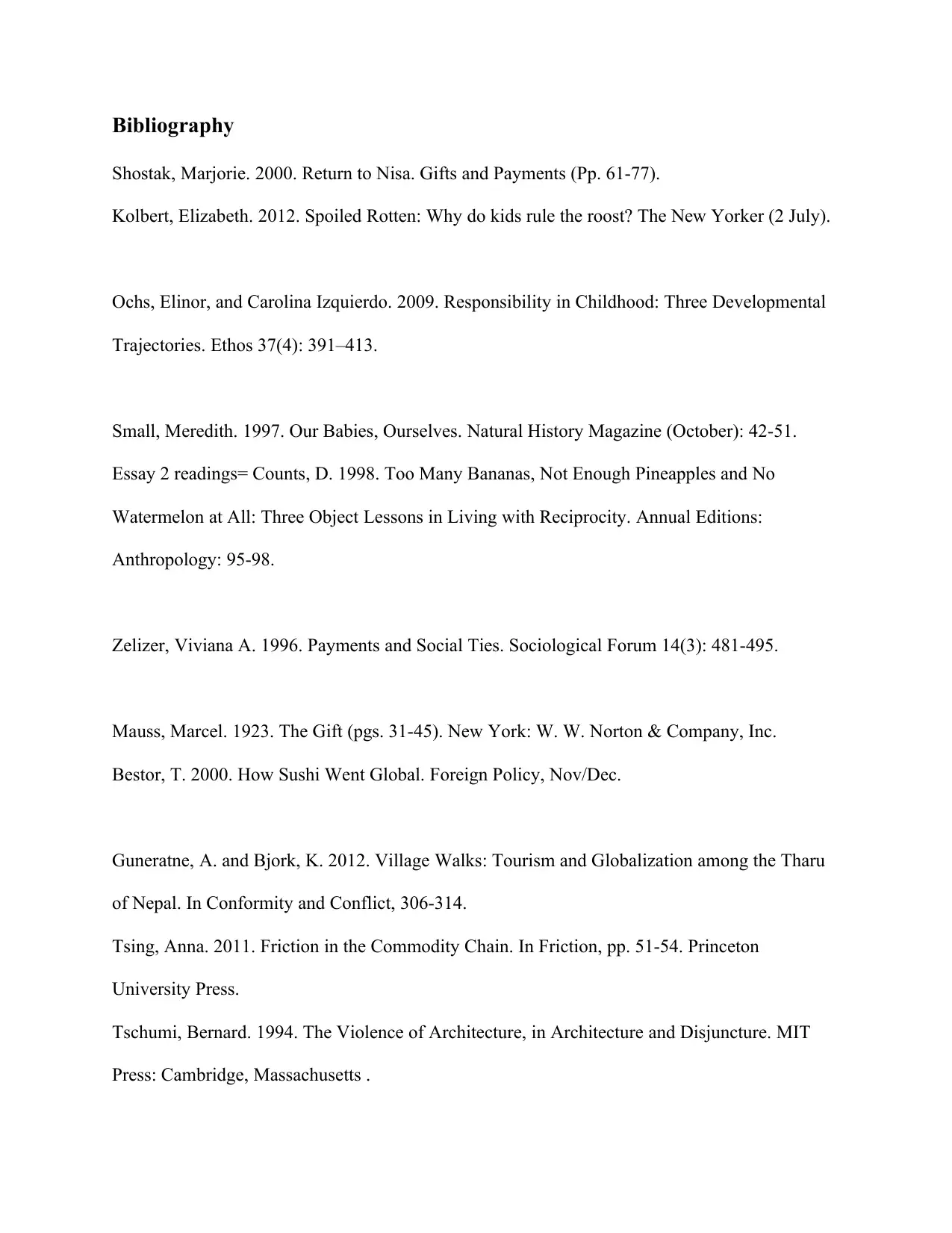
Bibliography
Shostak, Marjorie. 2000. Return to Nisa. Gifts and Payments (Pp. 61-77).
Kolbert, Elizabeth. 2012. Spoiled Rotten: Why do kids rule the roost? The New Yorker (2 July).
Ochs, Elinor, and Carolina Izquierdo. 2009. Responsibility in Childhood: Three Developmental
Trajectories. Ethos 37(4): 391–413.
Small, Meredith. 1997. Our Babies, Ourselves. Natural History Magazine (October): 42-51.
Essay 2 readings= Counts, D. 1998. Too Many Bananas, Not Enough Pineapples and No
Watermelon at All: Three Object Lessons in Living with Reciprocity. Annual Editions:
Anthropology: 95-98.
Zelizer, Viviana A. 1996. Payments and Social Ties. Sociological Forum 14(3): 481-495.
Mauss, Marcel. 1923. The Gift (pgs. 31-45). New York: W. W. Norton & Company, Inc.
Bestor, T. 2000. How Sushi Went Global. Foreign Policy, Nov/Dec.
Guneratne, A. and Bjork, K. 2012. Village Walks: Tourism and Globalization among the Tharu
of Nepal. In Conformity and Conflict, 306-314.
Tsing, Anna. 2011. Friction in the Commodity Chain. In Friction, pp. 51-54. Princeton
University Press.
Tschumi, Bernard. 1994. The Violence of Architecture, in Architecture and Disjuncture. MIT
Press: Cambridge, Massachusetts .
Shostak, Marjorie. 2000. Return to Nisa. Gifts and Payments (Pp. 61-77).
Kolbert, Elizabeth. 2012. Spoiled Rotten: Why do kids rule the roost? The New Yorker (2 July).
Ochs, Elinor, and Carolina Izquierdo. 2009. Responsibility in Childhood: Three Developmental
Trajectories. Ethos 37(4): 391–413.
Small, Meredith. 1997. Our Babies, Ourselves. Natural History Magazine (October): 42-51.
Essay 2 readings= Counts, D. 1998. Too Many Bananas, Not Enough Pineapples and No
Watermelon at All: Three Object Lessons in Living with Reciprocity. Annual Editions:
Anthropology: 95-98.
Zelizer, Viviana A. 1996. Payments and Social Ties. Sociological Forum 14(3): 481-495.
Mauss, Marcel. 1923. The Gift (pgs. 31-45). New York: W. W. Norton & Company, Inc.
Bestor, T. 2000. How Sushi Went Global. Foreign Policy, Nov/Dec.
Guneratne, A. and Bjork, K. 2012. Village Walks: Tourism and Globalization among the Tharu
of Nepal. In Conformity and Conflict, 306-314.
Tsing, Anna. 2011. Friction in the Commodity Chain. In Friction, pp. 51-54. Princeton
University Press.
Tschumi, Bernard. 1994. The Violence of Architecture, in Architecture and Disjuncture. MIT
Press: Cambridge, Massachusetts .
⊘ This is a preview!⊘
Do you want full access?
Subscribe today to unlock all pages.

Trusted by 1+ million students worldwide
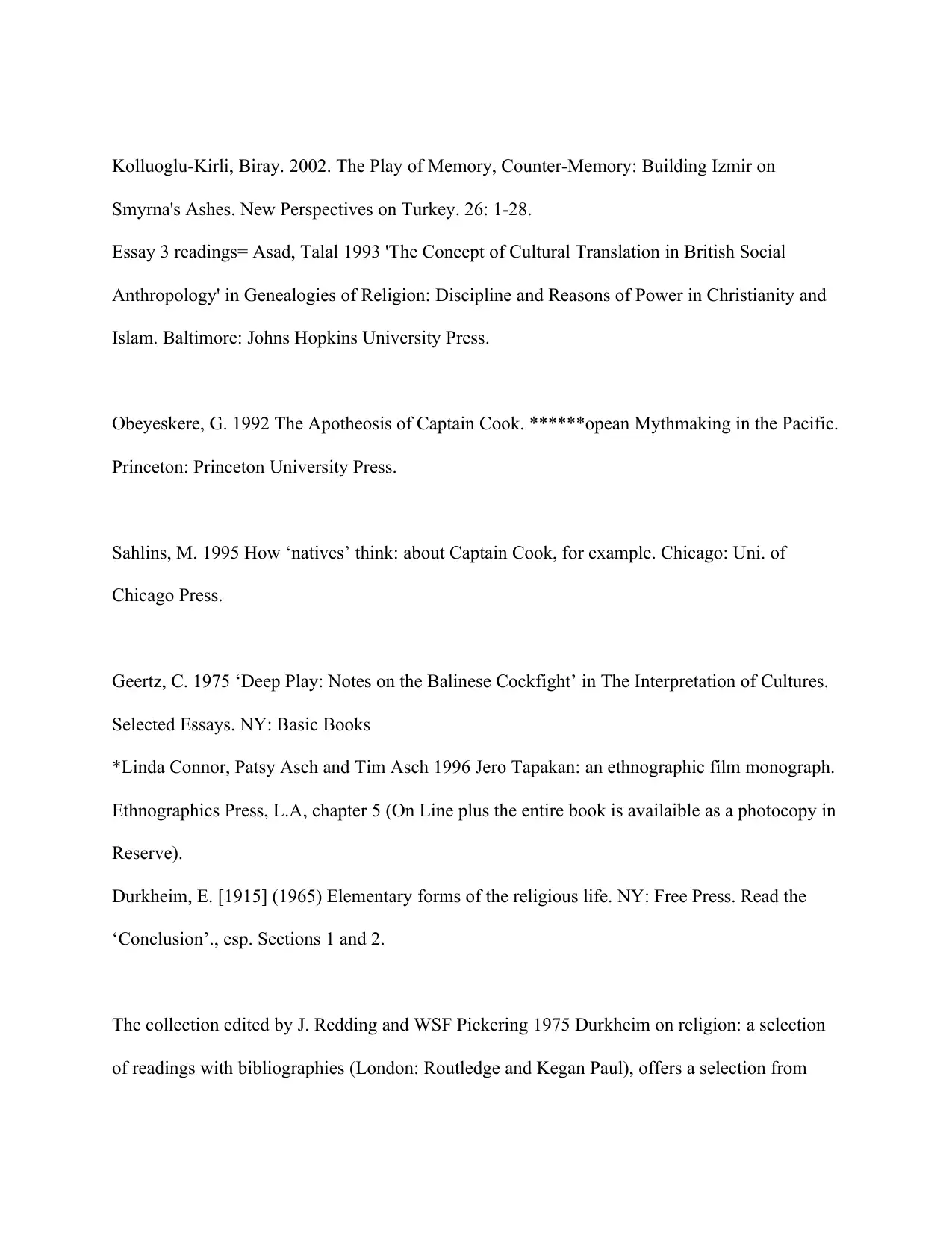
Kolluoglu-Kirli, Biray. 2002. The Play of Memory, Counter-Memory: Building Izmir on
Smyrna's Ashes. New Perspectives on Turkey. 26: 1-28.
Essay 3 readings= Asad, Talal 1993 'The Concept of Cultural Translation in British Social
Anthropology' in Genealogies of Religion: Discipline and Reasons of Power in Christianity and
Islam. Baltimore: Johns Hopkins University Press.
Obeyeskere, G. 1992 The Apotheosis of Captain Cook. ******opean Mythmaking in the Pacific.
Princeton: Princeton University Press.
Sahlins, M. 1995 How ‘natives’ think: about Captain Cook, for example. Chicago: Uni. of
Chicago Press.
Geertz, C. 1975 ‘Deep Play: Notes on the Balinese Cockfight’ in The Interpretation of Cultures.
Selected Essays. NY: Basic Books
*Linda Connor, Patsy Asch and Tim Asch 1996 Jero Tapakan: an ethnographic film monograph.
Ethnographics Press, L.A, chapter 5 (On Line plus the entire book is availaible as a photocopy in
Reserve).
Durkheim, E. [1915] (1965) Elementary forms of the religious life. NY: Free Press. Read the
‘Conclusion’., esp. Sections 1 and 2.
The collection edited by J. Redding and WSF Pickering 1975 Durkheim on religion: a selection
of readings with bibliographies (London: Routledge and Kegan Paul), offers a selection from
Smyrna's Ashes. New Perspectives on Turkey. 26: 1-28.
Essay 3 readings= Asad, Talal 1993 'The Concept of Cultural Translation in British Social
Anthropology' in Genealogies of Religion: Discipline and Reasons of Power in Christianity and
Islam. Baltimore: Johns Hopkins University Press.
Obeyeskere, G. 1992 The Apotheosis of Captain Cook. ******opean Mythmaking in the Pacific.
Princeton: Princeton University Press.
Sahlins, M. 1995 How ‘natives’ think: about Captain Cook, for example. Chicago: Uni. of
Chicago Press.
Geertz, C. 1975 ‘Deep Play: Notes on the Balinese Cockfight’ in The Interpretation of Cultures.
Selected Essays. NY: Basic Books
*Linda Connor, Patsy Asch and Tim Asch 1996 Jero Tapakan: an ethnographic film monograph.
Ethnographics Press, L.A, chapter 5 (On Line plus the entire book is availaible as a photocopy in
Reserve).
Durkheim, E. [1915] (1965) Elementary forms of the religious life. NY: Free Press. Read the
‘Conclusion’., esp. Sections 1 and 2.
The collection edited by J. Redding and WSF Pickering 1975 Durkheim on religion: a selection
of readings with bibliographies (London: Routledge and Kegan Paul), offers a selection from
Paraphrase This Document
Need a fresh take? Get an instant paraphrase of this document with our AI Paraphraser
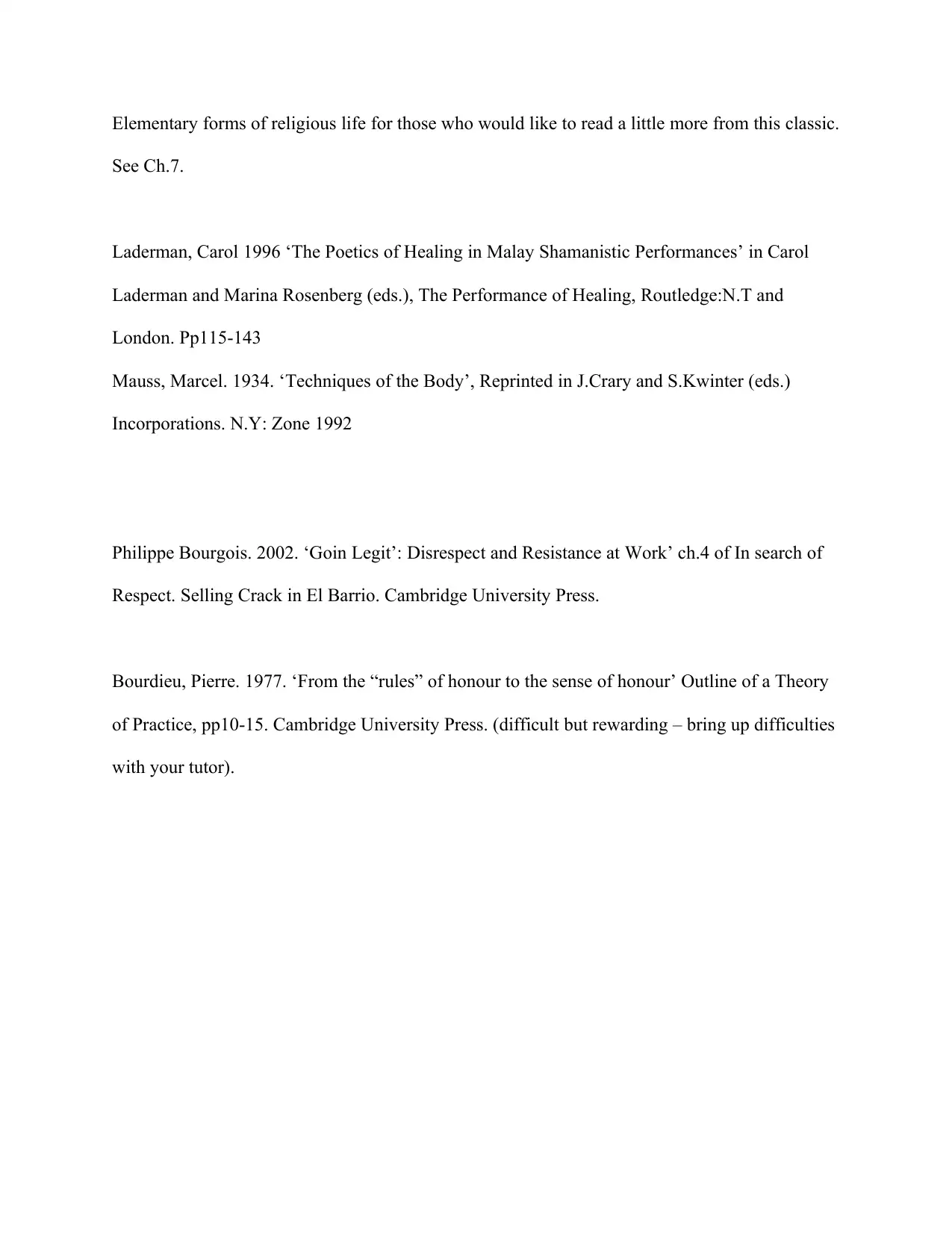
Elementary forms of religious life for those who would like to read a little more from this classic.
See Ch.7.
Laderman, Carol 1996 ‘The Poetics of Healing in Malay Shamanistic Performances’ in Carol
Laderman and Marina Rosenberg (eds.), The Performance of Healing, Routledge:N.T and
London. Pp115-143
Mauss, Marcel. 1934. ‘Techniques of the Body’, Reprinted in J.Crary and S.Kwinter (eds.)
Incorporations. N.Y: Zone 1992
Philippe Bourgois. 2002. ‘Goin Legit’: Disrespect and Resistance at Work’ ch.4 of In search of
Respect. Selling Crack in El Barrio. Cambridge University Press.
Bourdieu, Pierre. 1977. ‘From the “rules” of honour to the sense of honour’ Outline of a Theory
of Practice, pp10-15. Cambridge University Press. (difficult but rewarding – bring up difficulties
with your tutor).
See Ch.7.
Laderman, Carol 1996 ‘The Poetics of Healing in Malay Shamanistic Performances’ in Carol
Laderman and Marina Rosenberg (eds.), The Performance of Healing, Routledge:N.T and
London. Pp115-143
Mauss, Marcel. 1934. ‘Techniques of the Body’, Reprinted in J.Crary and S.Kwinter (eds.)
Incorporations. N.Y: Zone 1992
Philippe Bourgois. 2002. ‘Goin Legit’: Disrespect and Resistance at Work’ ch.4 of In search of
Respect. Selling Crack in El Barrio. Cambridge University Press.
Bourdieu, Pierre. 1977. ‘From the “rules” of honour to the sense of honour’ Outline of a Theory
of Practice, pp10-15. Cambridge University Press. (difficult but rewarding – bring up difficulties
with your tutor).
1 out of 11
Your All-in-One AI-Powered Toolkit for Academic Success.
+13062052269
info@desklib.com
Available 24*7 on WhatsApp / Email
![[object Object]](/_next/static/media/star-bottom.7253800d.svg)
Unlock your academic potential
Copyright © 2020–2025 A2Z Services. All Rights Reserved. Developed and managed by ZUCOL.